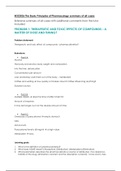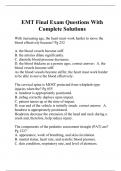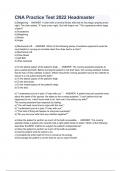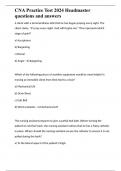3. TRIGONOMETRIC FUNCTIONS
INTRODUCTION
Trigonometry is the branch of mathematics concerned with measurement of the parts, sides,
and angles of a triangle. Plane trigonometry, which is the subject of this chapter, is
restricted to triangles lying in a plane. Trigonometry is based on certain ratios, called
trigonometric functions, with the early applications of the trigonometric functions being in
surveying, navigation, and engineering. These functions also play an important role in the
study of all sorts of vibratory phenomena – sound, light, electricity, etc. As a consequence, a
considerable portion of the subject matter is concerned with a study of the properties of and
relations among the trigonometric functions.
LEARNING OUTCOMES
On completion of this chapter, you will be able to:
Define (explain) radian measure and perform calculations pertaining to circular
measurements.
Demonstrate basic understanding of trigonometric functions.
Solve trigonometric equations.
Sketch graphs of the sine function and demonstrate understanding of simple harmonic
motion.
COMPILED BY T. PAEPAE
,TABLE OF CONTENTS
3. TRIGONOMETRIC FUNCTIONS ................................................................................... 0
3.1 CIRCULAR MEASUREMENTS .............................................................................. 2
3.1.1 Measurement of Angles ................................................................................... 3
3.1.2 Radian Measure – Conversion Between Degrees and Radians ....................... 3
3.1.3 Length of a Circular Arc ................................................................................... 5
3.1.4 The Circle and its Properties ............................................................................ 6
3.2 ANALYTIC TRIGONOMETRY .............................................................................. 11
3.2.1 Trigonometric Functions and Their Definitions ............................................... 16
3.2.2 Trigonometric Identities.................................................................................. 17
3.2.3 Using a Calculator to Evaluate Trigonometric Functions ................................ 19
3.4.1 Inverse Trigonometric Functions .................................................................... 21
3.4.2 Manipulation of Formulae............................................................................... 23
3.4.3 Trigonometric Equations ................................................................................ 26
3.5 GRAPHS OF THE SINE FUNCTION .................................................................... 34
3.5.1 The General Sine Graph ................................................................................ 35
3.5.2 The Shifted Sinusoidal Graph ........................................................................ 37
3.5.3 Finding the Equation of a Sinusoidal Graph ................................................... 40
3.5.4 Applications of the Sinusoidal Graph: Simple Harmonic Motion ..................... 43
1
,3.1 CIRCULAR MEASUREMENTS
Why it is important to understand: Circular Measurements
‘A circle is one of the fundamental shapes of geometry; it consists of all the points that are
equidistant from a central point. Knowledge of calculations involving circles is needed with
crank mechanisms, with determinations of latitude and longitude, with pendulums, and even
in the design of paper clips. The floodlit area at a football ground, the area an automatic
garden sprayer sprays and the angle of lap of a belt drive all rely on calculations involving
the arc of a circle. The ability to handle calculations involving circles and its properties is
clearly essential in several branches of engineering design.’ Bird, J., 2017. Higher
engineering mathematics. Routledge.
SPECIFIC OUTCOMES
On completion of this study unit, you will be able to:
Define a radian.
Convert angular measurements in degrees to angular measurements in radians and
vice versa.
State some properties of a circle – including radius, circumference, diameter, sector,
chord, segment and arc.
Perform calculations with circle sections, such as segments, sectors, arc lengths, radii,
chords, and angles.
2
, 3.1.1 Measurement of Angles
An angle AOB consists of two rays R1 and R 2 with a common vertex O (Figure 3-1). We
often interpret an angle as a rotation of the ray R1 onto R 2 . If the rotation is
counterclockwise, the angle is considered positive, and if the rotation is clockwise, the angle
is considered negative.
Figure 3-1: Measurement of Angles
Angle Measure
The measure of an angle is the amount of rotation about the vertex required to move R1
onto R 2 . Intuitively, this is how much the angle “opens”. One unit of measurement for angles
is the degree, which is used in applications such as navigation and surveying. In calculus
and other branches of mathematics, a more natural method of measuring angles is used:
radian measure; which is a scientific unit based on certain properties of a circle.
3.1.2 Radian Measure – Conversion Between Degrees and Radians
Definition of a Radian
Consider a circle with a radius r as indicated in the diagram below. The measurement of a
central angle is 1 radian (abbreviated rad) if and only if subtends (intercepts) an arc
whose length is equal to the radius of the circle.
sr
r
O
r
3
INTRODUCTION
Trigonometry is the branch of mathematics concerned with measurement of the parts, sides,
and angles of a triangle. Plane trigonometry, which is the subject of this chapter, is
restricted to triangles lying in a plane. Trigonometry is based on certain ratios, called
trigonometric functions, with the early applications of the trigonometric functions being in
surveying, navigation, and engineering. These functions also play an important role in the
study of all sorts of vibratory phenomena – sound, light, electricity, etc. As a consequence, a
considerable portion of the subject matter is concerned with a study of the properties of and
relations among the trigonometric functions.
LEARNING OUTCOMES
On completion of this chapter, you will be able to:
Define (explain) radian measure and perform calculations pertaining to circular
measurements.
Demonstrate basic understanding of trigonometric functions.
Solve trigonometric equations.
Sketch graphs of the sine function and demonstrate understanding of simple harmonic
motion.
COMPILED BY T. PAEPAE
,TABLE OF CONTENTS
3. TRIGONOMETRIC FUNCTIONS ................................................................................... 0
3.1 CIRCULAR MEASUREMENTS .............................................................................. 2
3.1.1 Measurement of Angles ................................................................................... 3
3.1.2 Radian Measure – Conversion Between Degrees and Radians ....................... 3
3.1.3 Length of a Circular Arc ................................................................................... 5
3.1.4 The Circle and its Properties ............................................................................ 6
3.2 ANALYTIC TRIGONOMETRY .............................................................................. 11
3.2.1 Trigonometric Functions and Their Definitions ............................................... 16
3.2.2 Trigonometric Identities.................................................................................. 17
3.2.3 Using a Calculator to Evaluate Trigonometric Functions ................................ 19
3.4.1 Inverse Trigonometric Functions .................................................................... 21
3.4.2 Manipulation of Formulae............................................................................... 23
3.4.3 Trigonometric Equations ................................................................................ 26
3.5 GRAPHS OF THE SINE FUNCTION .................................................................... 34
3.5.1 The General Sine Graph ................................................................................ 35
3.5.2 The Shifted Sinusoidal Graph ........................................................................ 37
3.5.3 Finding the Equation of a Sinusoidal Graph ................................................... 40
3.5.4 Applications of the Sinusoidal Graph: Simple Harmonic Motion ..................... 43
1
,3.1 CIRCULAR MEASUREMENTS
Why it is important to understand: Circular Measurements
‘A circle is one of the fundamental shapes of geometry; it consists of all the points that are
equidistant from a central point. Knowledge of calculations involving circles is needed with
crank mechanisms, with determinations of latitude and longitude, with pendulums, and even
in the design of paper clips. The floodlit area at a football ground, the area an automatic
garden sprayer sprays and the angle of lap of a belt drive all rely on calculations involving
the arc of a circle. The ability to handle calculations involving circles and its properties is
clearly essential in several branches of engineering design.’ Bird, J., 2017. Higher
engineering mathematics. Routledge.
SPECIFIC OUTCOMES
On completion of this study unit, you will be able to:
Define a radian.
Convert angular measurements in degrees to angular measurements in radians and
vice versa.
State some properties of a circle – including radius, circumference, diameter, sector,
chord, segment and arc.
Perform calculations with circle sections, such as segments, sectors, arc lengths, radii,
chords, and angles.
2
, 3.1.1 Measurement of Angles
An angle AOB consists of two rays R1 and R 2 with a common vertex O (Figure 3-1). We
often interpret an angle as a rotation of the ray R1 onto R 2 . If the rotation is
counterclockwise, the angle is considered positive, and if the rotation is clockwise, the angle
is considered negative.
Figure 3-1: Measurement of Angles
Angle Measure
The measure of an angle is the amount of rotation about the vertex required to move R1
onto R 2 . Intuitively, this is how much the angle “opens”. One unit of measurement for angles
is the degree, which is used in applications such as navigation and surveying. In calculus
and other branches of mathematics, a more natural method of measuring angles is used:
radian measure; which is a scientific unit based on certain properties of a circle.
3.1.2 Radian Measure – Conversion Between Degrees and Radians
Definition of a Radian
Consider a circle with a radius r as indicated in the diagram below. The measurement of a
central angle is 1 radian (abbreviated rad) if and only if subtends (intercepts) an arc
whose length is equal to the radius of the circle.
sr
r
O
r
3








